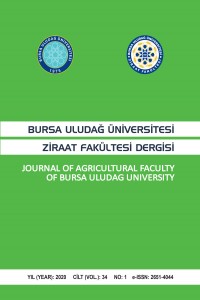Öz
Ülkemizin tarım ve tarıma dayalı endüstrisi açısından son derece önemli olan pamuk bitkisinin üretiminde, seyreltme işlemi yoğun işgücü gerektiren ve maliyeti yüksek bir işlemdir. Bu çalışmada, seyreltme işleminde insan işgücünden tasarruf ederek işlem maliyetini düşürecek bitki algılama sistemine sahip otomatik bir seyreltme makinasının tasarım ve prototip imalatı gerçekleştirilmiş ve makinanın tarla performansı belirlenmiştir. Prototip makinanın tarla denemelerinde teknik iş başarısı, sıra üzeri dağılım düzgünlüğü ve seyreltme başarısı değerleri 3 farklı hız (0.83, 2.09, 3.02 km h-1) ve 3 farklı sıra üzeri ekim mesafesi (5.8, 7.1, 9.8 cm) koşullarında belirlenmiştir. Tarla denemeleri neticesinde elde edilen bulgulara göre makinanın en yüksek teknik iş başarısı değerine (0.21 ha h-1), 3.02 km h-1 ilerleme hızı ve 9.8 cm sıra üzeri ekim mesafesinde, en yüksek seyreltme başarısına (%42.69) ise 0.83 km h-1 ilerleme hızı ve 9.8 cm sıra üzeri ekim mesafelerinde ulaştığı görülmüştür. Kabul edilen 70000 bitki ha-1 güvenilir sıklık değeri de dikkate alınarak yapılan değerlendirmeler, makinanın en uygun çalışma koşullarının 2.09 km h-1 ilerleme hızı ve 7.1 cm sıra üzeri ekim mesafesi olduğunu göstermiştir.
Anahtar Kelimeler
Destekleyen Kurum
Aydın Adnan Menderes Üniversitesi Bilimsel Araştırma Projeleri Fonu
Proje Numarası
FBE-08040
Teşekkür
FBE-08040 nolu Bilimsel Araştırma Projesine destek veren Aydın Adnan Menderes Üniversitesi Bilimsel Araştırma Projeleri Fonu’na teşekkür ederiz.
Kaynakça
- Algan, N. 1997. Tarla Bitkileri (Endüstri Bitkileri). Ege Üniversitesi Ziraat Fakültesi Yayınları, Ders Notları :52/1, Bornova-İzmir. 96p.
- Bashimov, G. 2016. Türkmenistan Pamuk Sektörünün Rekabetçilik Düzeyinin Analizi. Uludağ Üniversitesi Ziraat Fakültesi Dergisi, 30 (1), S:47-55.
- Çetin, M.D. ve Çelik, İ. 2012. Antalya Bölgesinde Pamuk Yetiştiriciliğinin Durumu ve Bazı Sorunlarına Genel Bir Bakış, Selçuk Üniversitesi Selçuk Tarım ve Gıda Bilimleri Dergisi 26 (4): 68-72.
- Mutaf, E., Uçucu R. 1980. Tarımsal Mekanizasyon. Ege Üniversitesi Ziraat Fakültesi Ders Teksiri, Bornovaİzmir. 316p.
- Önal, İ., 1977. Seyreltme Yönünden Değişik Ekim Metotlarının Matematik-İstatistik Esasları ve Ülkemiz Koşullarında Pamuk Seyreltmesinin Mekanizasyon Olanakları Üzerinde Bir Araştırma, Ege Üniversitesi Ziraat Fakültesi Yayınları No: 388, Bornova-İzmir.
- Önal, İ., 1995. Ekim, Bakım, Gübreleme Makinaları. Ege Üniversitesi Ziraat Fakültesi Yayınları No:490, Bornova –İzmir. 606p.
- Özarslan, C. and Yalçın, İ. 2004. Comparison of Different Thinning Applications in Cotton Farming, Pakistan Journal of Biological Sciences, 7 (5): 763-767.
- Özkan, İ. ve T. Kaya, 2002. Aydın İlinde Pamuğa Dayalı Sanayinin Bugünkü Durumu ve Geleceği, Türkiye V. Pamuk, Tekstil ve Konfeksiyon Sempozyumu, 28-29 Nisan, Diyarbakır, p:230-233.
- Yalçın, İ., 1999. Değişik Toprak İşleme ve Pamuk Ekim Tekniklerinin Aydın Yöresi Koşullarına Uygulama Olanakları. Doktora Tezi (Basılmamış), Ege Üniversitesi Fen Bilimleri Enstitüsü, Tarım Makinaları ABD, Bornova-İzmir.
Öz
Thinning is the labour intensive and high cost process of cotton plant cultivation. The cotton is one of the most important products of agriculture and agro-based industry in our country. In this study, the applicability of an automated cotton thinning machinery which will save human labour and reduce process costs based on plant sensing has been carried out. According to this purpose the design and prototype of an automated cotton thinning machinery has been conducted. Field performance of the machine was determined. In the field experiments, work efficiencies, uniformity of distribution and thinning efficiency have been determined for three different forward velocities (0.83, 2.09, 3.02 km h-1) and three different planting distances (5.8, 7.1, 9.8 cm). Field experiments were carried out on parcels using randomized block design. The results from field experiments showed that the highest work efficiency (0.21 ha h-1) for the automated cotton thinner was determined at 3.02 km h-1 forward velocity and 9.8 cm inter-row sowing distance. The highest success of thinning (%42.69) was obtained at 0.83 km h-1 forward velocity and 9.8 cm of inter-row sowing distance. It was observed from the results optimal working conditions of the machine are at 2.09 km h-1 forward velocity and 7.1 cm inter row sowing distance for the reliable plant density value of 70000 plants ha-1 in an acceptable range.
Anahtar Kelimeler
Proje Numarası
FBE-08040
Kaynakça
- Algan, N. 1997. Tarla Bitkileri (Endüstri Bitkileri). Ege Üniversitesi Ziraat Fakültesi Yayınları, Ders Notları :52/1, Bornova-İzmir. 96p.
- Bashimov, G. 2016. Türkmenistan Pamuk Sektörünün Rekabetçilik Düzeyinin Analizi. Uludağ Üniversitesi Ziraat Fakültesi Dergisi, 30 (1), S:47-55.
- Çetin, M.D. ve Çelik, İ. 2012. Antalya Bölgesinde Pamuk Yetiştiriciliğinin Durumu ve Bazı Sorunlarına Genel Bir Bakış, Selçuk Üniversitesi Selçuk Tarım ve Gıda Bilimleri Dergisi 26 (4): 68-72.
- Mutaf, E., Uçucu R. 1980. Tarımsal Mekanizasyon. Ege Üniversitesi Ziraat Fakültesi Ders Teksiri, Bornovaİzmir. 316p.
- Önal, İ., 1977. Seyreltme Yönünden Değişik Ekim Metotlarının Matematik-İstatistik Esasları ve Ülkemiz Koşullarında Pamuk Seyreltmesinin Mekanizasyon Olanakları Üzerinde Bir Araştırma, Ege Üniversitesi Ziraat Fakültesi Yayınları No: 388, Bornova-İzmir.
- Önal, İ., 1995. Ekim, Bakım, Gübreleme Makinaları. Ege Üniversitesi Ziraat Fakültesi Yayınları No:490, Bornova –İzmir. 606p.
- Özarslan, C. and Yalçın, İ. 2004. Comparison of Different Thinning Applications in Cotton Farming, Pakistan Journal of Biological Sciences, 7 (5): 763-767.
- Özkan, İ. ve T. Kaya, 2002. Aydın İlinde Pamuğa Dayalı Sanayinin Bugünkü Durumu ve Geleceği, Türkiye V. Pamuk, Tekstil ve Konfeksiyon Sempozyumu, 28-29 Nisan, Diyarbakır, p:230-233.
- Yalçın, İ., 1999. Değişik Toprak İşleme ve Pamuk Ekim Tekniklerinin Aydın Yöresi Koşullarına Uygulama Olanakları. Doktora Tezi (Basılmamış), Ege Üniversitesi Fen Bilimleri Enstitüsü, Tarım Makinaları ABD, Bornova-İzmir.
Ayrıntılar
| Birincil Dil | Türkçe |
|---|---|
| Konular | Ziraat Mühendisliği |
| Bölüm | Araştırma Makaleleri |
| Yazarlar | |
| Proje Numarası | FBE-08040 |
| Yayımlanma Tarihi | 1 Haziran 2020 |
| Gönderilme Tarihi | 23 Temmuz 2019 |
| Yayımlandığı Sayı | Yıl 2020 Cilt: 34 Sayı: 1 |
Journal of Agricultural Faculty of Bursa Uludag University is licensed under a Creative Commons Attribution-NonCommercial-NoDerivatives 4.0 International License.


